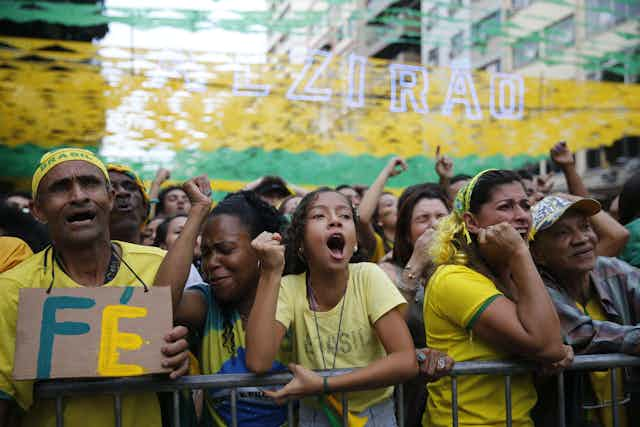Like many extremist and authoritarian leaders before him, outgoing Brazilian president Jair Bolsonaro seized on national symbols during his rise to power and tried to make them his own.
The national football shirt is a case in point. For years many Brazilians avoided wearing the famous yellow shirt because of its association with Bolsonaro and far-right politics.
You can listen to more articles from The Conversation, narrated by Noa, here.
But this might be starting to change because of Brazil’s matches in the World Cup, and who the current team represent. The players come from many different regions of the country, faiths and political positions. Central players like Neymar Jr, Richarlison and Vinicius Jr have widely different political perspectives. The first openly supports Bolsonaro, the other two are seen as liberal. Richarlison, whose acrobatic goal attracted global attention, is famous for his progressive political stance on and off the field. He made statements about the death of George Floyd, against the burning of Amazon rainforest and has advocated for vaccination against COVID-19. Vinicius Jr is also considered progressive and has been very vocal about anti-racism.
The team, therefore, crosses all sorts of divides and may be bringing together supporters from across Brazil, who come from different political backgrounds, for the first time in a while. Bolsonaro sought to polarise the nation during his years in power, according to many commentators, using confrontational rhetoric and conspiracy theories.
The question is whether Brazil’s performance in the World Cup can heal any of those divisions as the nation moves towards the inauguration of Luiz Inácio Lula da Silva as president on January 1. In its first match, Brazil’s impressive performance against Serbia confirmed the high level of its football, and brought crowds out on to the streets across the country.
During the game, many left-wingers – including president-elect Lula – took their dusty yellow shirts out of the closets.
I was out in the streets of Belo Horizonte, in the Brazilian state of Minas Gerais, with friends during the Serbia game. After Brazil’s victory, the audience where I was – most of whom were wearing the national shirt – erupted, singing songs supporting Lula.
The support for the yellow shirt seemed to grow during the Brazil game against Switzerland. Lula and members of the transitional government again wore the national shirt while watching the game in Brasília, the nation’s capital.
While Lula watched the game in Brasília and Eduardo Bolsonaro, the congressman son of the outgoing president, watched the game in Doha, I went to the house of a friend’s family in Belo Horizonte. The streets along the way were crowded with people wearing the national football team shirt. On my way home, I saw people celebrating, singing and playing samba. Unlike in the past few years, the yellow shirt was everywhere.
The history of Brazil’s football shirt
The national football shirt is an important symbol in Brazil, due to the importance of football in the country’s culture. The incoming government believes that the World Cup poses a valuable opportunity to reclaim the national football team shirt, along with other national symbols.
Before Bolsonaro’s rise to power, the national football shirt – along with the Brazilian flag – was initially used in protests against the left-wing Workers Party by unsatisfied portions of the population in 2013. During the 2018 elections, these symbols were used widely by Bolsonaro and his supporters.
Read more: Populism in Brazil: how liberalisation and austerity led to the rise of Lula and Bolsonaro
Over the past few years, Bolsonaro’s supporters have wrapped themselves in the football shirt and national flag in marches around the country. They argued that they were “taking the country back” and that the Brazilian flag “would never be red” – in reference to an imagined communist threat. Only during and after the recent presidential election have these symbols started to be “retaken” by the incoming government.
A similar trend of “owning” national symbols was observed during the government of former US president Donald Trump and leaders of the Brexit movement in the UK. Like Bolsonaro in Brazil, members of both movements attempted to capture national symbols, including flags, and vowed to “take back” their countries.
Bolsonaro’s next move
After his defeat in the 2022 presidential elections, Bolsonaro has rarely left his official residence, and has not even mentioned watching the World Cup. In recent weeks, the president faced a series of political, legal and symbolic defeats.
Some of Bolsonaro’s main political allies in Congress are starting to side with Lula. The president also faces various challenges in the electoral courts. Most recently, his party lost its last claim contesting the results of the elections in the superior electoral court. The court fined the party BRL 22.9 million (£3.5 million) for making unfounded allegations that threatened the electoral process.
Bolsonarismo is still very much alive. However, despite a few deluded supporters crying out for military intervention and criminals perpetrating acts of terror, things seem to be returning to some normality.
In the coming months, many Brazilians are hopeful that, while support for Bolsonaro will not disappear, the famous yellow shirt will be retaken as a symbol of the nation as a whole.

